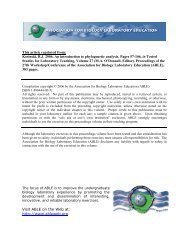Lumbriculus variegatus - Association for Biology Laboratory Education
Lumbriculus variegatus - Association for Biology Laboratory Education
Lumbriculus variegatus - Association for Biology Laboratory Education
You also want an ePaper? Increase the reach of your titles
YUMPU automatically turns print PDFs into web optimized ePapers that Google loves.
Lab Exercise Objectives<br />
1. Identify blackworms.<br />
Pulsation rate of blackworms 129<br />
2. Explain and identify key features and functions of the blackworm’s circulatory system.<br />
3. Describe blood vessel pulsations of a blackworm.<br />
4. Measure pulsation frequency and velocity.<br />
5. Explain the effect of drugs on the circulatory system of blackworms.<br />
6. Design and implement an investigation using blackworms.<br />
7. Present results and conclusions both in writing and orally.<br />
Timeline <strong>for</strong> Lab Activities<br />
Culturing/buying worms Start culturing 2-4 weeks in advance<br />
Cutting worms 24-48 hours in advance<br />
Making solutions 24 hours in advance<br />
Time needed <strong>for</strong> preparing lab ~5 hours if viewing slides have been<br />
previously made<br />
In-lab timing:<br />
Introduction 10 minutes<br />
Selecting and Handling worms 15 minutes<br />
Determining Baseline Rate (Part I) 30 minutes<br />
Designing Experiment (Part II) 20 minutes<br />
Running Experiment 45 minutes<br />
History of Blackworms in <strong>Biology</strong> Teaching Labs<br />
Prior to 1996, <strong>Lumbriculus</strong> <strong>variegatus</strong> was well known among fish hobbyists. Thanks to Dr. Charlie<br />
Drewes, the wonderful world of blackworms was introduced to biology teachers all over the nation by<br />
Dr. Drewes’ Carolina Tips article in 1996 and by his guest appearance (as an instructor) at the 1996<br />
Woodrow Wilson Institute at Princeton. Teachers from this institute have developed and shared many<br />
blackworm related lab ideas, which has made this lab exercise possible. Additionally, much in<strong>for</strong>mation<br />
about culturing, handling, and viewing blackworms was gained through Dr. Drewes’ website and other<br />
compositions.
















